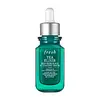What's inside
What's inside
 Key Ingredients
Key Ingredients

 Benefits
Benefits

 Concerns
Concerns

 Ingredients Side-by-side
Ingredients Side-by-side

Water
Skin ConditioningCoco-Caprylate
EmollientButylene Glycol
HumectantPentylene Glycol
Skin ConditioningGlycerin
HumectantLactobacillus/Wasabia Japonica Root Ferment Extract
AntioxidantSodium Acrylates Copolymer
Soy Isoflavones
Skin ConditioningHydrolyzed Prunus Domestica
Skin ConditioningDictyopteris Membranacea Extract
AntioxidantPancratium Maritimum Extract
BleachingDimethylmethoxy Chromanyl Palmitate
Skin ConditioningDimethylmethoxy Chromanol
AntioxidantOligopeptide-68
BleachingLepidium Sativum Sprout Extract
Skin ConditioningGlycine Soja Oil
EmollientLecithin
EmollientHydrogenated Lecithin
EmulsifyingPolysorbate 80
EmulsifyingAlcohol
AntimicrobialPhenoxyethanol
PreservativeSodium Oleate
CleansingDisodium EDTA
Water, Coco-Caprylate, Butylene Glycol, Pentylene Glycol, Glycerin, Lactobacillus/Wasabia Japonica Root Ferment Extract, Sodium Acrylates Copolymer, Soy Isoflavones, Hydrolyzed Prunus Domestica, Dictyopteris Membranacea Extract, Pancratium Maritimum Extract, Dimethylmethoxy Chromanyl Palmitate, Dimethylmethoxy Chromanol, Oligopeptide-68, Lepidium Sativum Sprout Extract, Glycine Soja Oil, Lecithin, Hydrogenated Lecithin, Polysorbate 80, Alcohol, Phenoxyethanol, Sodium Oleate, Disodium EDTA
Water
Skin ConditioningGlycerin
HumectantSimmondsia Chinensis Seed Oil
EmollientHelianthus Annuus Seed Oil
EmollientIsostearyl Alcohol
EmollientPropanediol
Solvent1,2-Hexanediol
Skin ConditioningNiacinamide
SmoothingPentylene Glycol
Skin ConditioningButylene Glycol Cocoate
EmulsifyingCellulose
AbsorbentMacrocystis Pyrifera Extract
Skin ConditioningCamellia Sinensis Leaf Extract
AntimicrobialArgania Spinosa Kernel Oil
EmollientHyaluronic Acid
HumectantCeramide NP
Skin ConditioningTocopheryl Acetate
AntioxidantTocopherol
AntioxidantMaltodextrin
AbsorbentAcrylates/C10-30 Alkyl Acrylate Crosspolymer
Emulsion StabilisingParfum
MaskingEthylcellulose
Xanthan Gum
EmulsifyingSodium Hyaluronate
HumectantSodium Hydroxide
BufferingAdenosine
Skin ConditioningBiosaccharide Gum-1
HumectantPhytosphingosine
Skin ConditioningHydrogenated Lecithin
EmulsifyingChlorphenesin
AntimicrobialPotassium Sorbate
PreservativeSodium Benzoate
MaskingLimonene
PerfumingLinalool
PerfumingCitronellol
PerfumingGeraniol
PerfumingWater, Glycerin, Simmondsia Chinensis Seed Oil, Helianthus Annuus Seed Oil, Isostearyl Alcohol, Propanediol, 1,2-Hexanediol, Niacinamide, Pentylene Glycol, Butylene Glycol Cocoate, Cellulose, Macrocystis Pyrifera Extract, Camellia Sinensis Leaf Extract, Argania Spinosa Kernel Oil, Hyaluronic Acid, Ceramide NP, Tocopheryl Acetate, Tocopherol, Maltodextrin, Acrylates/C10-30 Alkyl Acrylate Crosspolymer, Parfum, Ethylcellulose, Xanthan Gum, Sodium Hyaluronate, Sodium Hydroxide, Adenosine, Biosaccharide Gum-1, Phytosphingosine, Hydrogenated Lecithin, Chlorphenesin, Potassium Sorbate, Sodium Benzoate, Limonene, Linalool, Citronellol, Geraniol
 Reviews
Reviews

Ingredients Explained
These ingredients are found in both products.
Ingredients higher up in an ingredient list are typically present in a larger amount.
Glycerin is already naturally found in your skin. It helps moisturize and protect your skin.
A study from 2016 found glycerin to be more effective as a humectant than AHAs and hyaluronic acid.
As a humectant, it helps the skin stay hydrated by pulling moisture to your skin. The low molecular weight of glycerin allows it to pull moisture into the deeper layers of your skin.
Hydrated skin improves your skin barrier; Your skin barrier helps protect against irritants and bacteria.
Glycerin has also been found to have antimicrobial and antiviral properties. Due to these properties, glycerin is often used in wound and burn treatments.
In cosmetics, glycerin is usually derived from plants such as soybean or palm. However, it can also be sourced from animals, such as tallow or animal fat.
This ingredient is organic, colorless, odorless, and non-toxic.
Glycerin is the name for this ingredient in American English. British English uses Glycerol/Glycerine.
Learn more about GlycerinHydrogenated Lecithin is created from the hydrogenation of lecithin (a group of phospholipids). Hydrogenation is a chemical reaction between hydrogen and another element.
This ingredient is an emollient and emulsifier. As an emollient, it helps soften skin by trapping moisture within. As an emulsifier, it prevents oil and water ingredients from separating.
Pentylene glycol is typically used within a product to thicken it. It also adds a smooth, soft, and moisturizing feel to the product. It is naturally found in plants such as sugar beets.
The hydrophilic trait of Pentylene Glycol makes it a humectant. As a humectant, Pentylene Glycol helps draw moisture from the air to your skin. This can help keep your skin hydrated.
This property also makes Pentylene Glycol a great texture enhancer. It can also help thicken or stabilize a product.
Pentylene Glycol also acts as a mild preservative and helps to keep a product microbe-free.
Some people may experience mild eye and skin irritation from Pentylene Glycol. We always recommend speaking with a professional about using this ingredient in your routine.
Pentylene Glycol has a low molecular weight and is part of the 1,2-glycol family.
Learn more about Pentylene GlycolWater. It's the most common cosmetic ingredient of all. You'll usually see it at the top of ingredient lists, meaning that it makes up the largest part of the product.
So why is it so popular? Water most often acts as a solvent - this means that it helps dissolve other ingredients into the formulation.
You'll also recognize water as that liquid we all need to stay alive. If you see this, drink a glass of water. Stay hydrated!
Learn more about Water